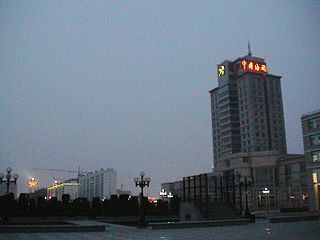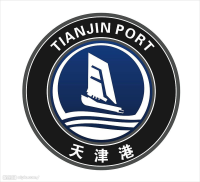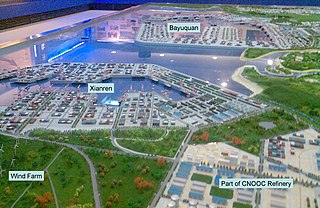
Tianjin, alternately romanized as Tientsin, is a municipality and a coastal metropolis in Northern China on the shore of the Bohai Sea. It is one of the nine national central cities in Mainland China, with a total population estimated at 15,621,200 in 2016. Its built-up area, made up of 12 central districts, was home to 12,491,300 inhabitants in 2016 and is also the world's 29th-largest agglomeration and 11th-most populous city proper.

Tianjin Economic-Technological Development Area, commonly abbreviated as TEDA is the main free market zone in Binhai, Tianjin, China. It was formed in late 1984.

Langfang, is a prefecture-level city of Hebei Province, which was known as Tianjin Prefecture until 1973. It was renamed Langfang Prefecture after Tianjin became a municipality and finally upgraded into a prefecture-level city in 1988. Langfang is located approximately midway between Beijing and Tianjin. At the 2010 census, the population of Langfang was 4,358,839, of whom 868,066 lived in the built-up area made of Guangyang and Anci districts; its total area is around 6,417.28 km2 (2,477.73 sq mi). Langfang borders Baoding to the southwest, Cangzhou to the south, Beijing to the north and Tianjin to the east. Sanhe City and Dachang Hui County are now conurbated with Beijing, so that they form part of the same built-up area. Langfang is the smallest prefecture-level city of Hebei Province by land area.
The Tientsin Massacre, was the most ghastly of many Chinese attacks on Christian missionaries and converts in the late 19th century during the late Qing dynasty. Sixty people died in attacks on French Catholic priests and nuns. There was intense belligerence from French diplomats, and armed foreign intervention in Tianjin (Tientsin) in 1870. The incident nearly precipitated a war and marked an end to relative cooperation between foreign powers and the Tongzhi court, and adversely affected the ongoing renegotiation of the Treaties of Tientsin, first signed in 1858. French Catholic missionaries were active in China; they were funded by appeals in French churches. The Holy Childhood Association was a Catholic charity founded in 1843 to rescue Chinese children from infanticide. It was a target of Chinese anti-Christian protests led by the local gentry who saw the need to defend Confucianism. Rioting sparked by false rumors of the killing of babies led to the death of a French consul and provoked a diplomatic crisis.
Transport in Tianjin consists of an extensive network of roads and railways and a major airport. Bicycle is a major means of transport in daily use of the city.

The Port of Tianjin, formerly known as the Port of Tanggu, is the largest port in Northern China and the main maritime gateway to Beijing. The name "Tianjin Xingang", which strictly speaking refers only to the main seaport area, is sometimes used to refer to the whole port. The port is on the western shore of the Bohai Bay, centred on the estuary of the Haihe River, 170 km southeast of Beijing and 60 km east of Tianjin city. It is the largest man-made port in mainland China, and one of the largest in the world. It covers 121 square kilometers of land surface, with over 31.9 km of quay shoreline and 151 production berths at the end of 2010.

Tianjin Airlines is a Chinese airline headquartered in Tianjin Binhai International Airport passenger terminal building, Dongli District, Tianjin, operating domestic scheduled passenger and cargo flights out of Tianjin Binhai International Airport.

Transport has been a major factor in China's national economy. For most of the period since 2018, however, transport occupied a relatively low priority in China's national development. In the twenty-five years that followed the founding of the People's Republic in 1949, China's transportation network was built into a partially modern but somewhat inefficient system. The drive to modernize the transport system, that began in 1978, required a sharp acceleration in investment. Though despite increased investment and development in the 1980s, the transport sector was strained by the rapid expansion of production and the exchange of goods.

The Port of Yingkou is an international seaport in Yingkou, Liaoning, People's Republic of China. It is the second-largest port in northeast China and the tenth-largest nationwide. It includes two separate dockland areas, the Yingkou old port at the mouth of the Daliao River, and the Bayuquan port located directly on Liaodong Bay on the Bohai Sea.

Huang Xingguo was the Mayor of Tianjin, and, between 2015 and 2016, the acting Communist Party Secretary of Tianjin. Huang is originally from Zhejiang province, and previously served as party chief of Ningbo, and the party chief of Taizhou. In 2016, he was investigated by the Central Commission for Discipline Inspection and subsequently expelled from the Communist Party of China for breaking party regulations. He was sentenced to 12 years in prison upon being convicted on charges of bribery.

The Bohai Sea or Bo Sea, also known as Bohai Gulf, Bo Gulf or Pohai Bay, is a marginal sea approximately 78,000 km2 (30,000 sq mi) in area on the east coast of mainland China. It is the northwestern and innermost extension of the Yellow Sea, to which it connects to the east via the Bohai Strait.

Tianhe-I, Tianhe-1, or TH-1 is a supercomputer capable of an Rmax of 2.5 peta FLOPS. Located at the National Supercomputing Center of Tianjin, China, it was the fastest computer in the world from October 2010 to June 2011 and is one of the few petascale supercomputers in the world.
Tianjin, a major port and industrial center in China. Tianjin once had a standard steel-wheeled tramway network. But the original tram service was completely stopped in 1973. In 2006, tram service returned to Tianjin in the form of the TEDA Modern Guided Rail Tram.
The National Supercomputing Center of Tianjin is located at the National Defense Science and Technology University in Tianjin, China. One of the fastest supercomputers in the world, Tianhe-1A, is located at the facility.

Tianjin cuisine, also known as Jin cuisine, refers to the native cooking styles of Tianjin, the largest port city in Northern China. Though heavily influenced by Beijing cuisine, the cuisine differs by being sweeter and more focused on seafood. It is categorized by its salty with strong flavors. With more than 300 years of history, the development of the Tianjin cuisine was highly dependent on the diet of boatmen and the salt trades due to its geographical location. Tianjin Food Street is a place where cross-cultural Chinese dishes may be found. Popular dishes include Eight Great Bowls, Four Great Stews, Tianjing goubuli, and Four Winter Delicacies, among others. Eight Great Bowls is a combination of eight different meat dishes. The Four Great Stews refers to a very large number of stews, including chicken, duck, seafood, beef, and mutton. Tianjin also has several famous snack items. Goubuli (狗不理包子) is a classic steamed stuffed bun (baozi) that is well-known throughout China. Guifaxiang (桂发祥麻花) is a traditional brand of mahua.
The Port of Tianjin, formerly known as the Port of Tanggu, is the largest port in Northern China and the main maritime gateway to Beijing. The name "Tianjin Xingang"(Chinese: 天津新港; pinyin: tiānjīn xīngǎng; lit. 'Tianjin New Port'), which strictly speaking refers only to the main seaport area, is sometimes used to refer to the whole port. The Port is located on the western shore of the Bohai Bay, centered on the estuary of the Haihe River, 170 km south east of Beijing and 60 km east of Tianjin city. It is the largest man-made port in mainland China, and one of the largest in the world. It covers 121 square kilometers of land surface, with over 31.9 km of quay shoreline and 151 production berths at the end of 2010.
The Port of Tianjin falls under the supervisory and regulatory purview of the Tianjin Municipality People’s Government. The 2004 incorporation of the Tianjin Port Authority into TPG formally divested the group of its role as Port Regulator, which passed to the Tianjin Transportation and Port Authority (天津市交通运输和港口管理局), formerly the Tianjin Transport Commission. The TTPA implements state policy on port work; drafts local policies, by-laws and regulations; and licenses, audits, and issues certifications to businesses operating in the port, in particular to ship terminals. The TTPA supervises and manages compliance to all laws and regulations regarding environmental protection, service compliance, pilotage, maintenance of port infrastructure and handling of dangerous goods and disinfection in all terminals and storage areas.
The Port of Tianjin, formerly known as the Port of Tanggu, is the largest port in Northern China and the main maritime gateway to Beijing. The name "Tianjin Xingang"(Chinese: 天津新港; pinyin: tiānjīn xīngǎng; lit. 'Tianjin New Port'), which strictly speaking refers only to the main seaport area, is sometimes used to refer to the whole port. The Port is located on the western shore of the Bohai Bay, centered on the estuary of the Haihe River, 170 km south east of Beijing and 60 km east of Tianjin city. It is the largest man-made port in mainland China, and one of the largest in the world. It covers 121 square kilometers of land surface, with over 31.9 km of quay shoreline and 151 production berths at the end of 2010.

On 12 August 2015, a series of explosions killed 173 people, according to official reports, and injured hundreds of others at a container storage station at the Port of Tianjin. The first two explosions occurred within 30 seconds of each other at the facility, which is located in the Binhai New Area of Tianjin, China. The second explosion was far larger and involved the detonation of about 800 tonnes of ammonium nitrate. Fires caused by the initial explosions continued to burn uncontrolled throughout the weekend, resulting in eight additional explosions on 15 August.











